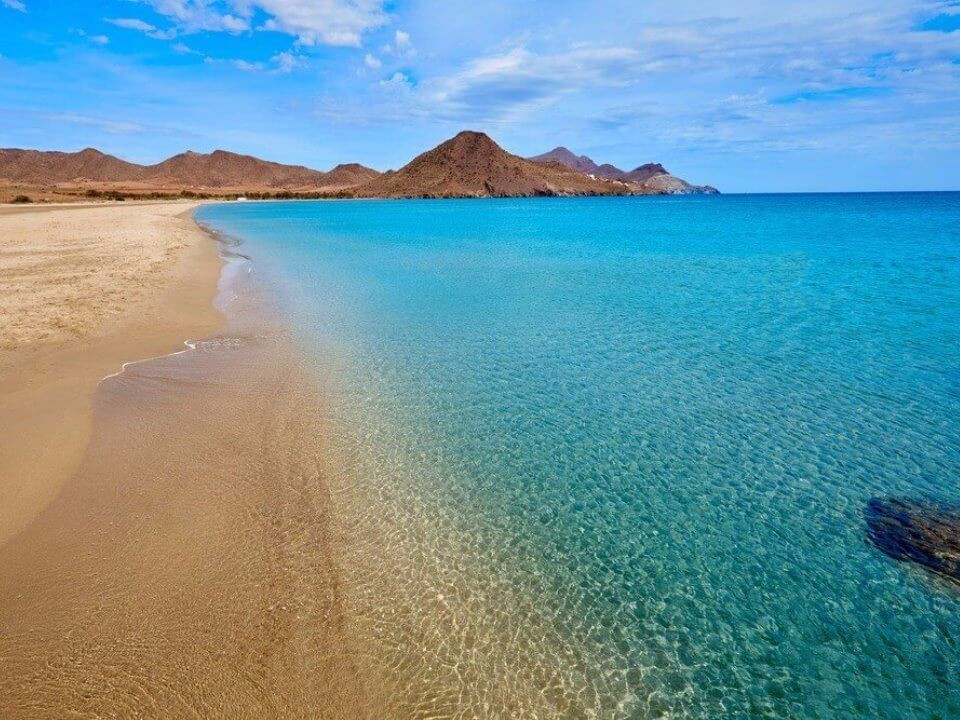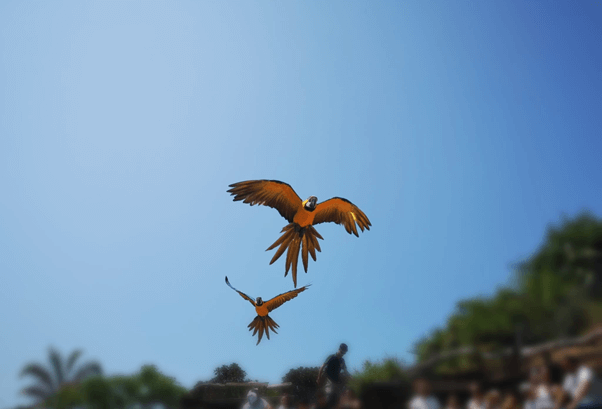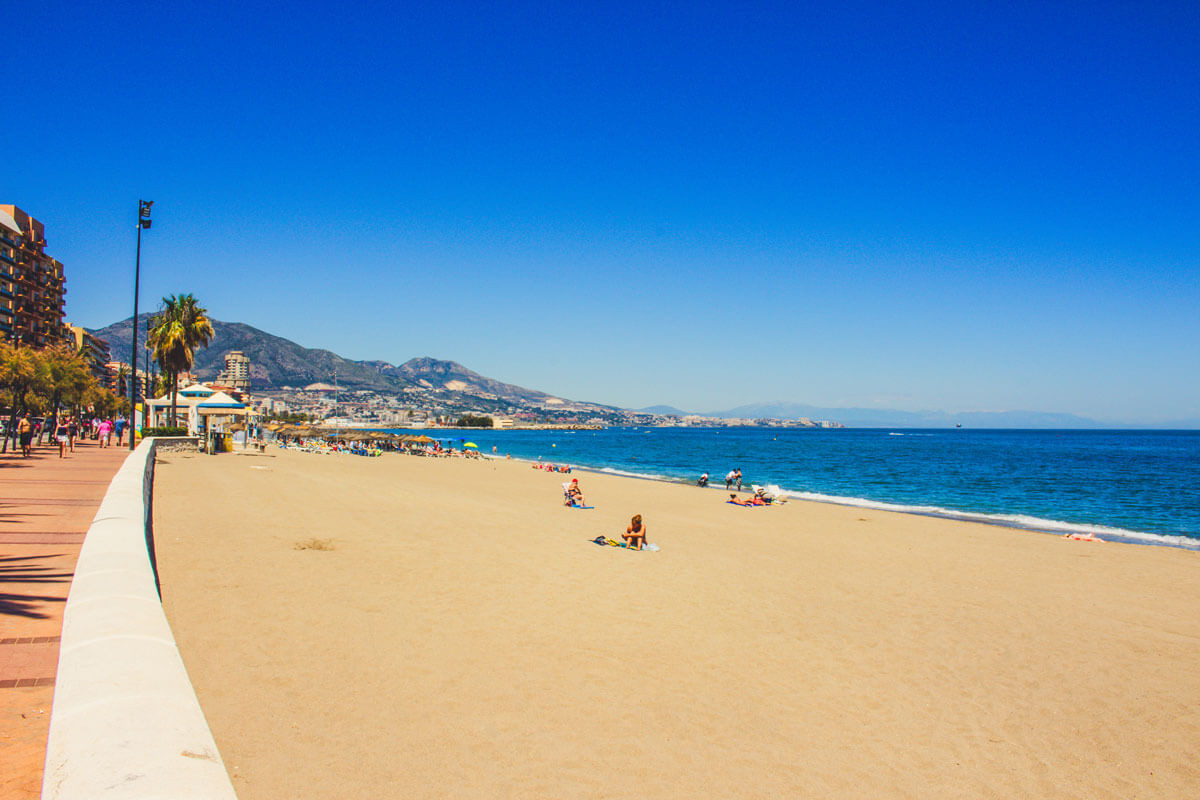Andalucia is world-famous for its 800km of coastline: here are a variety of spectacular beaches with white sands and crystal-clear turquoise waters. The Blue Flag has been awarded to certain beaches with excellent standards of hygiene, health, safety, accessibility, information, and lifeguards.
Playa del Cristo (Estepona) – Blue Flag

Playa del Cristo just outside Estepona is a small bay with lovely sand and crystal-clear water. It is popular with families. The beach is safe, sheltered and clean with blue flag status. Chiringuitos on the beach provide food and drink throughout the day with sun loungers and public toilets available too. If you’re there at sunset, you can watch the sunset behind the rock of Gibraltar. It also great for paddle boarders as it has clear shallow water and small waves.
Calahonda Beach (Motril, Granada) – Blue Flag
 The Costa Tropical’s most southern town owns one of the most spectacular beaches in Andalucía, the beach of Calahonda. Its name means “deep cove” as the seashore deepens right after meeting the water. The beach which is very busy but has great facilities has been receiving the Blue Flag for years now.
The Costa Tropical’s most southern town owns one of the most spectacular beaches in Andalucía, the beach of Calahonda. Its name means “deep cove” as the seashore deepens right after meeting the water. The beach which is very busy but has great facilities has been receiving the Blue Flag for years now.
Enjoy a drink in a delightfully old-school establishment while the bartender cuts you impossibly thin slices of the delicious ham is a great, authentic experience that everyone should try while in Spain!
Calahonda Beach (Nerja)

You can kill two birds with one stone here. Either spend some time on this small 120-metre-long beach and then visit Nerja’s historic centre, or the other way round. This small beach is situated in a hidden cove where the waters are clear and calm and make it a haven for snorkelling and scuba diving. There are basic facilities for chiringuitos, sunbeds and parasols for hire.
Maro Beach (Maro, Nerja) – Blue Flag

Playa de Maro is very beautiful – off-the-beaten-path, backed by cliffs, with turquoise waters, and surrounded by beautiful wild vegetation; it’s well worth the effort of getting there, despite the tricky parking plus a short walk. The beach is popular with snorkellers and scuba-divers, due to the clear waters inhabited by an abundance of fish, the sheltered situation, and the rock formations around the headlands either side. The beach has been recognised by the Blue Flag award for its cleanliness and good facilities. The 500-metre-long cave of Maro lies in the Natural Park of Acantilados de Maro, 5 km from Nerja.
Bolonia Beach (Tarifa, Cadiz)

Bolonia is just up the coast from Tarifa, off the beaten track. This 4 km long beach and the 30-metre-high Dunes are landmarks of the Costa de la Luz with its white, Caribbean-like sand. The strong wind also attracts the wind and kite-surfing crowd. This town has everything: Roman ruins, hip juice bars and wooden beach restaurants (chiringuitos) serving fresh fish, and a beautiful wide sweep of golden sand, backed by a grassy flower-covered bank, ending in a steep pine-forested dune.
El Palmar Beach (Vejer de la Frontera, Cádiz)
One of the best beaches is close to Vejer de la Frontera and the crystal-clear water is this beach’s most noteworthy feature, as well as the facilities provided. Even though it is one of the least crowded beaches in Andalucía, you will find chiringuitos offering seafood dishes, and horse-riding tours. El Palmar is a very long beach where you can enjoy peace and quiet and just a little windy, which makes it ideal for windsurfers.

Los Alemanes Beach (Zahara de los Atunes, Cádiz)
This 1.5km beach got its name from the German troops that used this bay during WWII. One of the reasons is that this beach is particularly hard to get to, due to the proximity of the mountain, which shelters the beach of Los Alemanes, away from prying eyes. There are some facilities like parking, showers, life guards but the town Zahara de los Atunes provides this uncrowded beach with many more facilities.

Caños de Meca Beach (Barbate, Cadiz)
Caños de Meca is the name of a district that belongs to the bigger area of Barbate. It comprises various beaches, stretching from the Tómbolo de Trafalgar (lighthouse) to La Breña Natural Park. Different features characterise them so that you can enjoy your favourite one, depending on what you feel like doing. During the low tide, you can walk along the shore, over the rocks to get to secluded little bays

Playa de las Negras (Las Negras, Almería)
Las Negras is a small picturesque, fishing village that owns a beach of the same name and the surrounding landscape is amazing. The name Las Negras comes from El Cerro Negro, the black volcanic rock flanking the town, whose pebbles fill the beach of Las Negras. However, if you want a more secluded beach, visit the Cala de San Pedro, 4 km north of Las Negras. Nudism is allowed here, due to the rocks that shelter this 225-metre-long bay.

Los Genoveses Beach (San José, Almería)

Cabo de Gata National Park in Almeria has some truly stunning, though little-known, beaches, gloriously pristine and mercifully undeveloped. Los Genoveses is one of the most perfectly picturesque – a large horseshoe-shaped bay with shallow water, bookended by impressive cliffs, and reached by a short, easy walk from a car park. As with all the beaches in this area, don’t expect any facilities (although it’s conveniently close to San Jose, the park’s main town). It’s just you and nature. 2.4 km from the beach of Monsul, there lies the beachof Los Genoveses. You can leave your car in the nearby parking but beware it has limited capacity. Make sure to visit this beach on a windless day, since the thin sand can get a little annoying, also remember to take your garbage away with you.
Monsul Beach (San José, Almeria)
The Monsul beach, next to Los Genoveses beach, is one of the most popular and busiest beaches inside Cabo de Gata natural park. This beach’s iconic landmark is a lava formation right in the middle of the sea. This rock and the marine life that you can see below the crystal-clear water makes it a must if you’re in Cabo de Gata. FYI this was also where some scenes for Indiana Jones and the Last Crusade and The Never-ending Story were filmed.

Matalascañas Beach (Matalascañas, Huelva)
The urban beach of Matalascañas stretches 5 kilometres between the Torre de la Higuera and El Coto. It has several facilities, and it has been awarded the Blue Flag for its water cleanliness. The closest beach to Seville, this is a resort town with a split personality – as you arrive, to the right you see miles of empty sand backed by dunes – this is part of Doñana National Park, only accessible to those on foot or bike (also on the other side of the town); to the left are modern high-rise apartment blocks and cafes with a promenade behind the sand. Hugely popular with day trippers and groups of young; expect loud music and excitable teenagers. Plenty of chiringuitos and sun beds or turn right if you want a quieter spot.

Mazagón Beach (Mazagón, Huelva)
Another broad and sandy beach with excellent services is that of Mazagón. The beach continues to the east of the town. The 9km of beach provides the inhabitants of Huelva with great day outs. The best way to enjoy this landscape surrounded by cliffs is going on horse ride at sunset. Moreover, the further you get from the port, the better, as the water is cleaner and less crowded.






